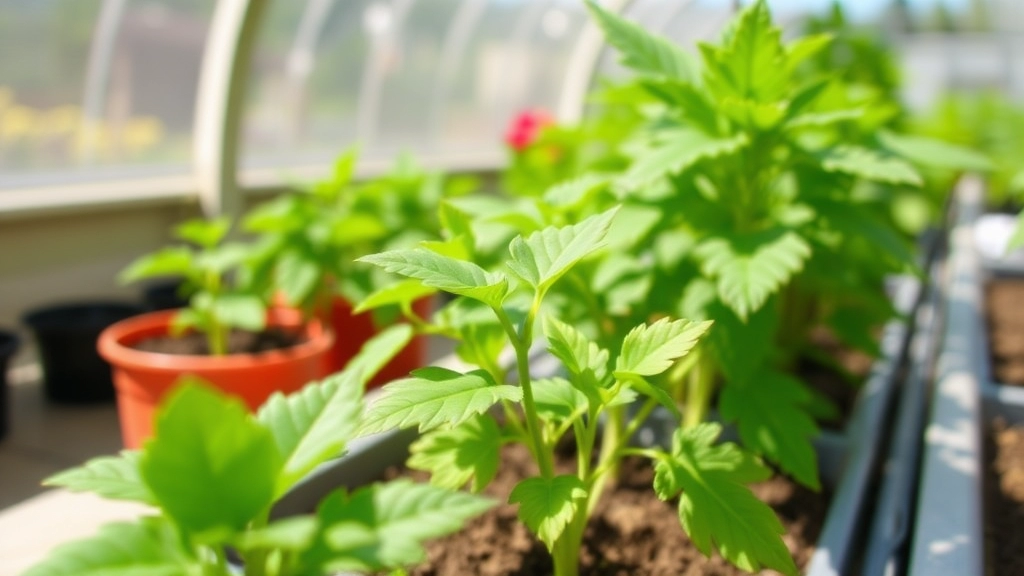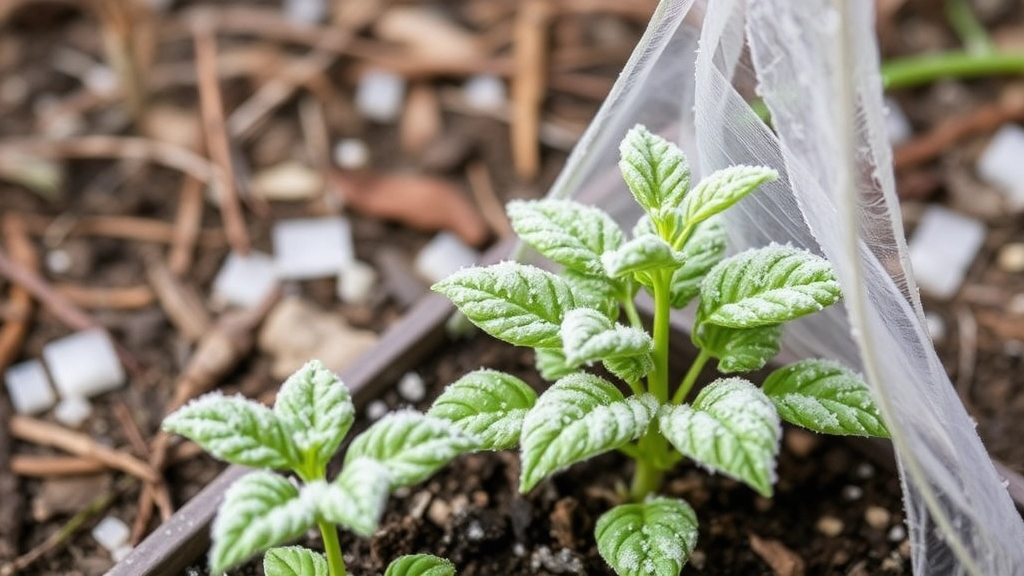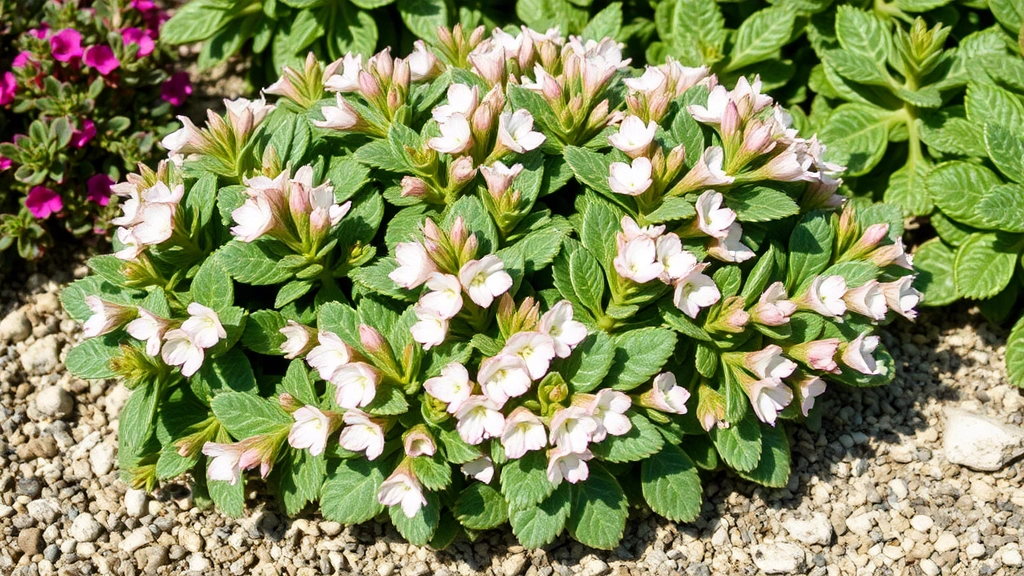Kalanchoe Silver Strand: A Unique Succulent
When it comes to unique succulents, the Kalanchoe Silver Strand stands out with its silvery-gray leaves and toothed margins. This variety of Kalanchoe is a favourite among succulent enthusiasts for its striking appearance and low-maintenance care. Whether you’re a seasoned plant parent or a newbie, understanding the specifics of this plant can help you keep it thriving.
Growing Conditions
The Kalanchoe Silver Strand thrives in bright, indirect light and well-draining soil. It’s essential to water it sparingly, allowing the soil to dry out completely between waterings to prevent root rot.
Propagation Tips
If you’re looking to add this beauty to your collection, knowing how to propagate it through stem and leaf cuttings can be a game-changer. Keep reading for more tips on indoor care, outdoor cultivation, and pest prevention.
Unique Features of Kalanchoe Silver Strand
When considering houseplants, many of us seek unique characteristics that set them apart. Kalanchoe Silver Strand is a captivating succulent that certainly fits this bill.
This plant is renowned for its striking silver-grey foliage, which creates a stunning contrast against more traditional green houseplants. The leaves are thick and fleshy, typical of succulents, and they shimmer in the light, adding a touch of elegance to any space.
Key Characteristics:
- Silvery Leaves: The unique colouration is a result of a natural waxy coating that helps the plant retain moisture.
- Compact Growth: Kalanchoe Silver Strand maintains a tidy, compact form, making it perfect for smaller spaces.
- Flowering Potential: While primarily admired for its foliage, it can produce small, tubular flowers under the right conditions, adding an extra layer of beauty.
- Drought Tolerance: Like many succulents, this plant is highly drought-resistant, making it an excellent choice for those who may forget to water regularly.
These features not only make Kalanchoe Silver Strand visually appealing but also practical for indoor gardening. For more tips on how to care for your Kalanchoe, check out our expert tips on caring for Kalanchoe succulents. Additionally, if you’re interested in exploring other varieties, you might find this guide to different Kalanchoe species useful.
Ideal Growing Conditions: Light, Water, and Soil Requirements

So, you’ve got your Kalanchoe Silver Strand, and you’re probably wondering how to keep it thriving, right?
Light Requirements
First off, let’s talk about light.
- Bright, Indirect Sunlight: Kalanchoe Silver Strand loves the sun but not too much direct sunlight.
- Window Placement: A spot near a south or west-facing window is perfect. If the leaves start to look a bit scorched, it might be getting too much sun.
Watering Needs
Next up is watering.
- Drench and Dry: Water your plant thoroughly, then let the soil dry out completely before the next drink.
- Signs of Thirst: If the leaves start to look wrinkly, it’s time to give it some water. But be careful—overwatering can lead to root rot.
Soil Preferences
Now, let’s get into soil.
- Well-Draining Mix: Use a cactus or succulent potting mix. This ensures excess water drains away quickly.
- DIY Option: You can also mix regular potting soil with sand or perlite to boost drainage.
Best Practices for Indoor Care
When it comes to nurturing your Kalanchoe Silver Strand indoors, there are several key practices that can ensure your plant thrives. Many enthusiasts often wonder how to maintain the ideal environment for their beloved succulents.
Light Requirements
Kalanchoe Silver Strand flourishes in bright, indirect sunlight.
- Placement: Position it near a south or west-facing window.
- Rotation: Rotate the pot every few weeks to ensure even growth.
Watering Techniques
Overwatering is a common concern, as it can lead to root rot.
- Frequency: Water only when the top inch of soil feels dry.
- Method: Use the âsoak and dryâ method; thoroughly water the plant and let excess drain out.
Soil Selection
Choosing the right soil is crucial for the health of your Kalanchoe.
- Type: Opt for a well-draining cactus or succulent mix.
- Amendments: Consider adding perlite or sand to enhance drainage.
Humidity and Temperature
Kalanchoe Silver Strand prefers a dry environment.
- Humidity: Keep humidity levels low; they thrive in arid conditions.
- Temperature: Maintain a temperature range of 18-24°C (65-75°F) for optimal growth.
Fertilisation
Feeding your Kalanchoe can boost its growth.
Outdoor Cultivation Tips: Protecting Against Frost

When it comes to cultivating Kalanchoe Silver Strand outdoors, one of the major concerns is protecting it from frost. This succulent thrives in warm conditions, and frost can be detrimental to its health.
Key Strategies to Protect Your Kalanchoe Silver Strand from Frost
- Choose the Right Location:
- Plant your Kalanchoe in a spot that receives ample sunlight but is also shielded from harsh winds.
- A south-facing wall can provide warmth and protection.
- Timing is Everything:
- If you live in an area prone to late frosts, consider planting your Kalanchoe after the last frost date in spring.
- Monitor local weather forecasts to stay informed about unexpected cold snaps.
- Use Mulch:
- Apply a layer of mulch around the base of your plant.
- This helps retain heat in the soil and protects the roots from freezing temperatures.
- Covering Techniques:
- Use frost cloths or blankets to cover your plants during particularly cold nights.
- Ensure the cover is secure but allows for some airflow to prevent moisture buildup.
- Container Planting:
- If possible, grow your Kalanchoe in pots.
- This allows you to move them indoors during frosty nights, providing them with a warm environment.
- Heat Sources:
- In extreme cases, consider using outdoor heat lamps or string lights to provide additional warmth.
By implementing these strategies, you can significantly reduce the risk of frost damage to your Kalanchoe Silver Strand.
Propagation Methods: Stem and Leaf Cuttings
Have you ever wondered how to expand your collection of Kalanchoe Silver Strand?
Propagation through stem and leaf cuttings is a straightforward and rewarding method.
Common Pests and How to Prevent Them

So, you’ve got your Kalanchoe Silver Strand thriving, but what happens when those pesky pests decide to crash the party?
It’s a common worry for plant lovers. You want your succulent to look its best, but aphids, mealybugs, and spider mites can sneak in and ruin your day. Here’s how to spot them and keep your plant safe.
Identifying Common Pests
- Aphids: Tiny, green or black bugs that cluster on new growth.
- Mealybugs: White, cottony spots that often hide in leaf joints.
- Spider Mites: Tiny and often invisible, they leave fine webs on your plant.
Prevention Tips
- Keep It Clean: Regularly wipe down leaves with a damp cloth. This discourages pests and keeps your plant looking sharp.
- Check for Infestations: Inspect your Kalanchoe weekly. Early detection is key to keeping pests at bay.
- Use Natural Remedies: A simple soap solution can work wonders. Mix a few drops of dish soap with water and spray it on affected areas.
- Avoid Overwatering: Pests love damp conditions. Ensure your plant has good drainage to prevent any waterlogging.
- Quarantine New Plants: If you bring home a new succulent, keep it separate for a few weeks. This way, you can ensure it’s pest-free before introducing it to your collection.
By being proactive, you can keep your Kalanchoe Silver Strand healthy and pest-free.
Frequently Asked Questions About Kalanchoe Silver Strand
As we delve deeper into the world of Kalanchoe Silver Strand, it’s essential to address some common queries that many plant enthusiasts have. These questions can help clarify concerns and enhance your gardening experience.
What is Kalanchoe Silver Strand?
Kalanchoe Silver Strand is a stunning succulent known for its silvery-green leaves and unique growth habit. Many people are drawn to its aesthetic appeal and low maintenance requirements.
How often should I water my Kalanchoe Silver Strand?
- Watering Frequency: Allow the soil to dry out completely between waterings.
- Seasonal Changes: During the growing season (spring and summer), water every 2-3 weeks. In winter, reduce this to once a month.
Does Kalanchoe Silver Strand need direct sunlight?
- Light Requirements: This plant thrives in bright, indirect sunlight.
- Avoiding Burn: Too much direct sun can scorch the leaves, so it’s best to provide filtered light.
Can I grow Kalanchoe Silver Strand indoors?
Absolutely! Kalanchoe Silver Strand is perfect for indoor settings. Just ensure it receives adequate light and is not overwatered.
What type of soil is best for Kalanchoe Silver Strand?
- Soil Type: A well-draining cactus or succulent mix is ideal.
- DIY Option: You can create your own mix by combining potting soil with sand and perlite.
How do I propagate Kalanchoe Silver Strand?
- Stem Cuttings: Cut a healthy stem and let it dry for a few days before planting it in soil.
- Leaf Cuttings: Similarly, a healthy leaf can be placed on soil to encourage root growth. For more detailed steps, check out our guide on how to propagate Kalanchoe leaves.
What pests should I watch out for?
Common pests include:
- Mealybugs: Look for white, cotton-like clusters on leaves.
- Aphids: Tiny, green bugs that can cluster on new growth.
How can I prevent pests?
- Regular Checks: Inspect your plants weekly.
- Natural Remedies: Use neem oil or insecticidal soap as a preventative measure.
Is Kalanchoe Silver Strand toxic to pets?
No, Kalanchoe Silver Strand is considered non-toxic to both cats and dogs, making it a safe choice for pet owners. However, if you’re interested in other pet-safe options, you might want to explore our guide on Kalanchoe toxicity.
FAQs about Kalanchoe Silver Strand
What kind of light does Kalanchoe Silver Strand need?
Kalanchoe Silver Strand thrives in bright, indirect sunlight. A spot near a south or west-facing window is ideal. If the leaves start to look scorched, it might be getting too much direct sunlight.
How often should I water my Kalanchoe Silver Strand?
Follow the drench and dry method: water your plant thoroughly, then let the soil dry out completely before watering again. If the leaves look wrinkly, it’s time to water, but be cautious of overwatering to avoid root rot.
What type of soil is best for Kalanchoe Silver Strand?
A well-draining mix is essential. Use a cactus or succulent potting mix, or mix regular potting soil with sand or perlite to improve drainage.
Can I grow Kalanchoe Silver Strand outdoors?
Yes, but you need to protect it from frost. Plant it in a sunny, sheltered location and consider using mulch, frost cloths, or even moving it indoors during frosty nights.
What are the common pests that affect Kalanchoe Silver Strand?
Common pests include aphids, mealybugs, and spider mites. These can cause damage to your plant if not managed properly.
How can I prevent pests on my Kalanchoe Silver Strand?
Prevention tips include regularly wiping down leaves, inspecting the plant weekly, using natural remedies like a soap solution, avoiding overwatering, and quarantining new plants before introducing them to your collection.
What should I do if my Kalanchoe Silver Strand gets frost damage?
Move the plant to a warmer location immediately. If it’s potted, bring it indoors. Trim any damaged parts to encourage new growth and protect it from future frost exposure.
Can I use regular potting soil for Kalanchoe Silver Strand?
Regular potting soil can be used if mixed with sand or perlite to improve drainage. However, a cactus or succulent potting mix is generally recommended for best results.
How can I tell if my Kalanchoe Silver Strand is getting too much water?
Signs of overwatering include yellowing leaves and a mushy stem. Ensure the soil dries out completely between waterings to prevent this issue.
Is it necessary to fertilize Kalanchoe Silver Strand?
While not strictly necessary, occasional feeding during the growing season can promote healthy growth. Use a balanced, water-soluble fertilizer diluted to half strength.
References
-
How to Care for Kalanchoe Silver Strand
-
Kalanchoe Plant Care
-
Kalanchoe: How to Grow and Care for Kalanchoe Plants
